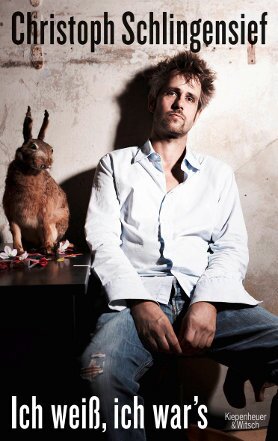Non-fiction
Christoph Schlingensief
Ich weiß, ich war's
[I know it was me] – Ed. Aino Laberenz
Christoph Schlingensief
Ich weiß, ich war's
[I know it was me]
This book was showcased during the special focus on Russian (2012 - 2014).
Review
Provocateur, rebel, enfant terrible. These are all labels people like to use when describing Christoph Schlingensief. But such categories have always seemed too narrow for one of Germany’s most complex contemporary artists. While his films, stage productions and performances often have been construed as aesthetic attacks on the zeitgeist, his unique talent lies in his ability to combine meticulously choreographed imagery with the explosiveness of improvisation. Engaging with Schlingensief means embracing the unexpected.
This maxim can also be applied to his book "Ich weiß, ich war's" [“I know, it was me”]. When discussing his performance of “The Flying Dutchman” in Manaus, Brazil, for example, he doesn’t reflect on Wagner, instead he talks about the sloths that hang lazily in the trees there. Almost all the time. "But once a week the sloth comes down to take a shit and a Jaguar is waiting for it under the tree. The question is: Why does the sloth do that? Because it wants to be polite? Because it thinks, ‘I'd rather climb down and take a dump because I might shit on somebody’s head?’ I think the sloth goes down because, every so often, it needs to face the object of its fear, it makes him feel alive."
This anecdote describes, of course, Schlingensief himself. Few German artists have as productively worked through their fears as he has. And this is no truer than in his fight against cancer, which he lost at the early age of 49. His brilliant "Fluxus-Oratorium" The Church of Fear, which posthumously earned him the Golden Lion of the Venice Biennale, was subtitled with a quote by Joseph Beuys: "Show your wound and you will be healed." That was his motto too. Who else, while dealing with rampantly spreading metastases, could have staged his own Requiem, en passant, to invoke each of those demons? Only Schlingensief.
Three years after his death, the work Ich weiß, ich war's, edited by his widow Aino Laberenz, shows a vibrant self-portrait of an exceptional artist. These notes that Schlingensief wrote in the final two years of his life should not be mistaken for an autobiography. "Christopher wanted a book of penultimate words, of unfinished thoughts," writes Laberenz in the preface. In fact, the book is not a final artists' book rather it is an open-ended compendium of reflections about a life with, by, and for the arts.
If Schlingensief’s life and work have always functioned as a symbiotic whole, then this biographical Aperçus is precisely what makes Ich weiß, ich war's so fascinating. A scene from his youth is particularly illuminating. Christoph’s father took him to a meeting at the Lions Club in 1976. The keynote speaker was Joseph Beuys. The 16-year-old immediately was fascinated by the man with the hat. The middle-class audience had been standing around bored until Beuys boomed: "I can guarantee you that in seven years this social system will be completely destroyed." The audience instantly was galvanized. Schlingensief was fascinated by the fact, "that somebody could take a whole room filled with people dozing off and cause a total uproar with a single sentence; that a prediction, a single thought, could force people to react."
He would later hone this skill to perfection. When he founded the Chance 2000 party at the Vienna Festival and erected a platform with a container of asylum seekers with the slogan: “Ausländer raus“ [“Foreigners out!”] or called for the "artistic murder" of Helmut Kohl, it caused the German media to hyperventilate. But Schlingensief’s actions were never cynical. He always believed in the potential of art to create a discourse. Even when he called on Germanic ghosts, whether in films such as: 100 years Adolf Hitler or stage productions such as Rocky Dutschke, or in his productions of Parsifal in Bayreuth, he was never able to let go of German guilt, German myths and German obsessions. Because Germany was for Schlingensief what Austria was for Thomas Bernhard: a rusty nail to hang his heart on and let it bleed to death.
The last project close to his heart was the Opera Village Africa, located in Burkina Faso. He fought to the very end to create a school, theater and hospital ward on 14 acres of land. When he spoke about this great project, which partially opened in 2011, he was concerned it might be misconstrued as selling indulgences for development aid policy or as "lofty art crap". Today, given the first exhibitions taking place there, he needn’t fear any longer. The Opera Village Africa is being carefully nurtured and becoming precisely the kind of social sculpture he always had dreamed of. Christoph Schlingensief’s presence is deeply missed. From Berlin to Burkina Faso.
Translated by Zaia Alexander
By Nils Markwardt
Nils Markwardt is a freelance writer contributing to publications such as Literaturen and der Freitag.


